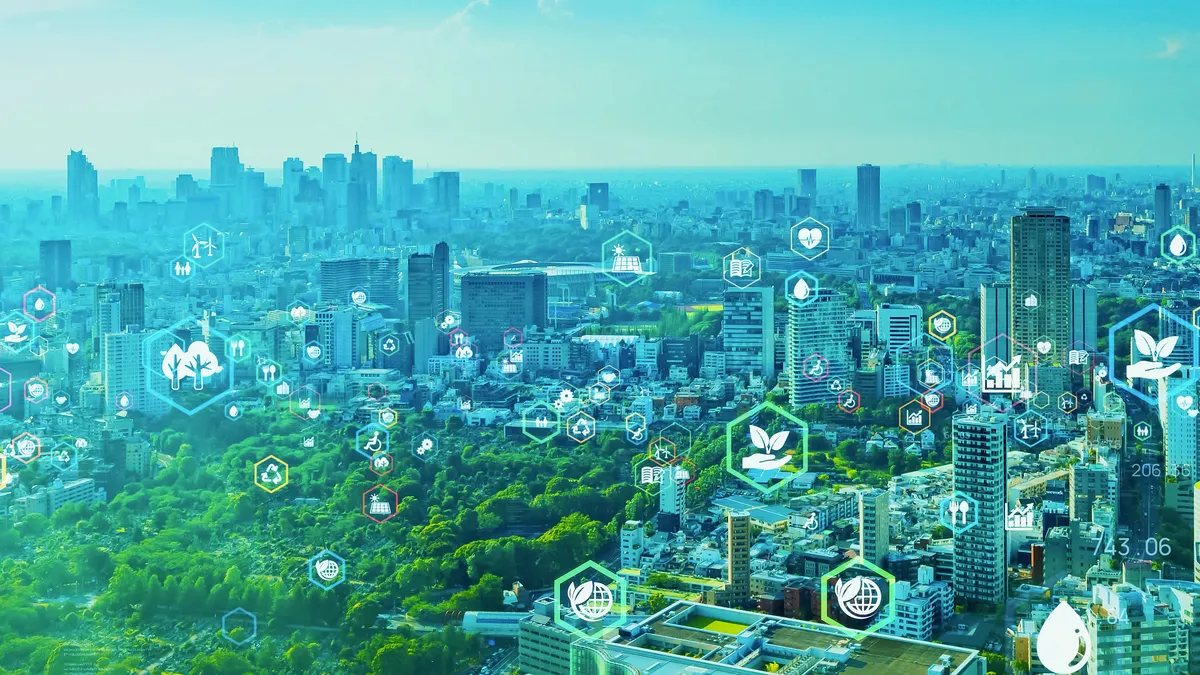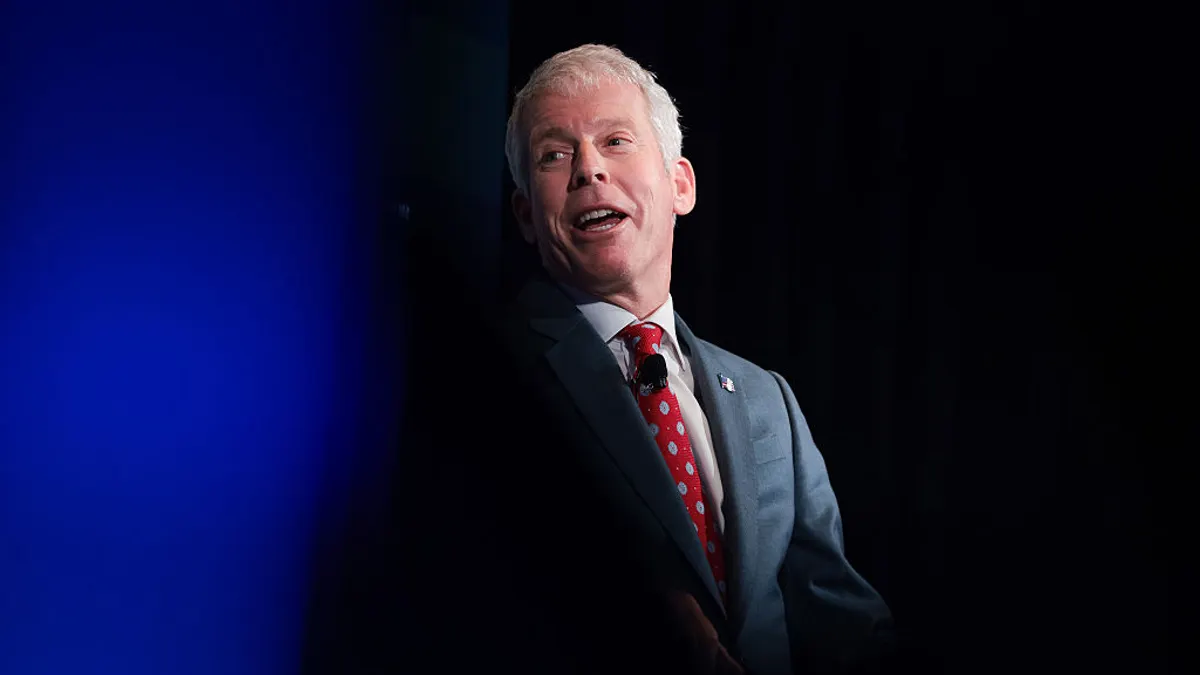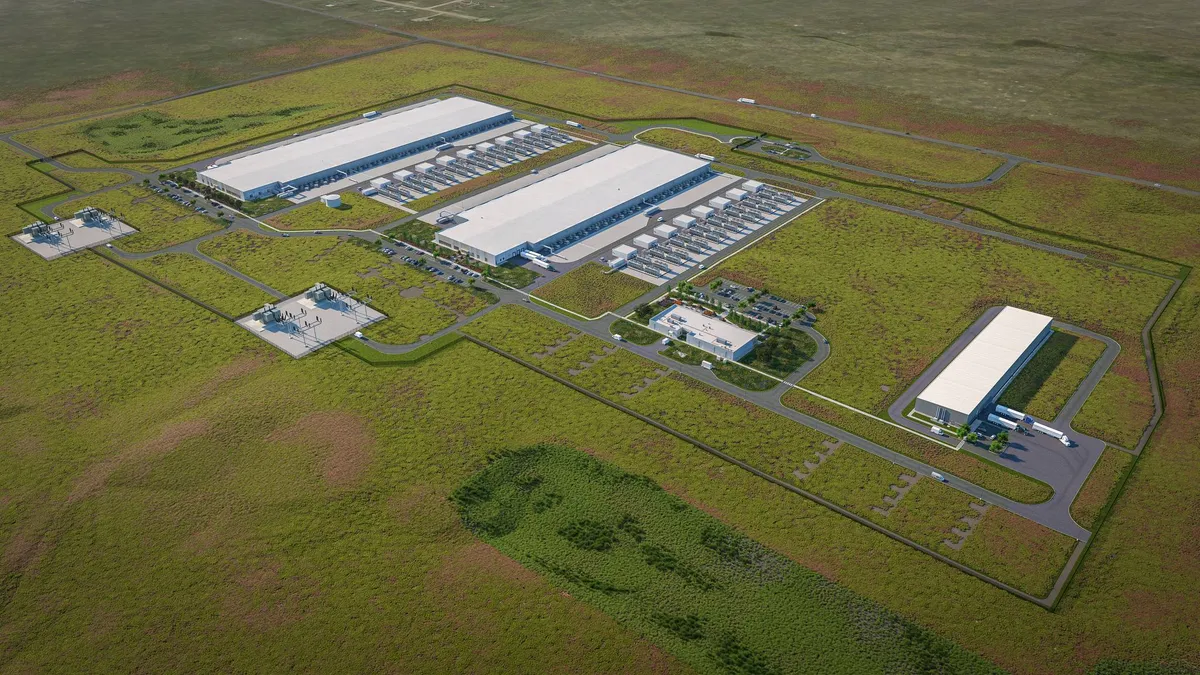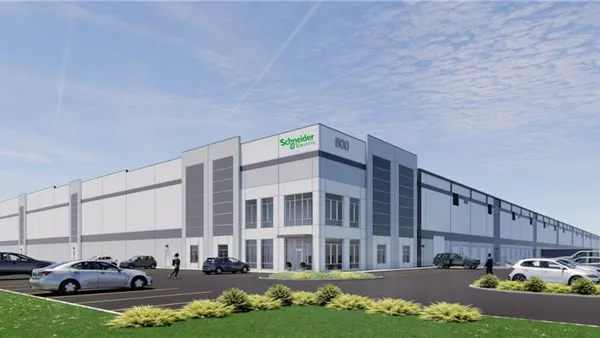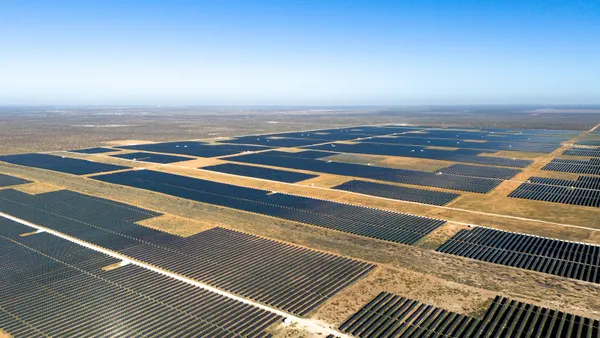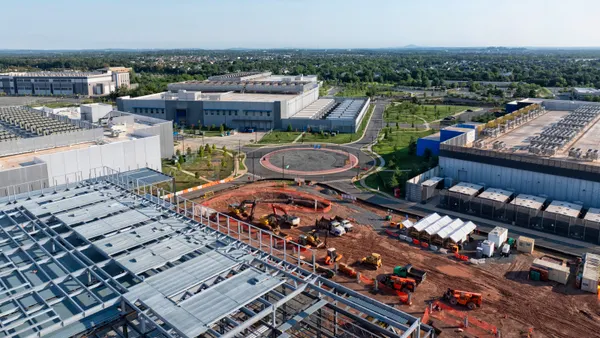What does innovation mean?
“Adopting new ideas, processes, and technologies for positive change.”
Utilities have been steeped in paper processes since their beginning. Most utility work is done outside of an office setting. Even today, some of the most technologically savvy utilities still use spreadsheet printouts, paper forms, and plotted maps for much of their mobile work. Legacy processes, especially those involving mobile workers, are time-consuming, error-prone, and costly.
The US Bureau of Labor Statistics projects that more than “10% of highly skilled employees working in infrastructure will retire each year for the next decade.” So utilities and associated engineering, design, and construction firms must build, upgrade, and operate facilities at an unparalleled pace with fewer employees. Utilities can ill afford to waste valuable employee resources on ineffective and inefficient processes. Consumers are already reeling with extended call waiting times for routine calls. Utilities can barely keep up with residential solar interconnections.
Mobile GIS is one of the technologies that can create positive change and ignite innovation while shredding the paper processes. Given the changes utilities face, they cannot afford to waste time with outdated and ineffective processes.
Changes Are Happening Fast
The electric utility industry is facing enormous challenges over the next decade. So innovation at a large and small scale is needed. If the US energy system is to transition from fossil fuel-based to carbon-free, it must make drastic changes. The following graphic from the NREL study dramatically shows the possible future. Today, the US uses nearly 100 quadrillion BTUs of energy. 60% of the electric generation today and nearly all the energy used for transportation comes from fossil fuels.
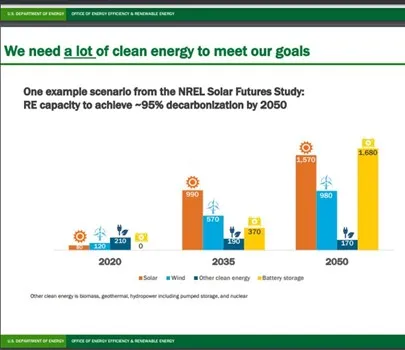
Innovation will be needed to leap from a fossil-fuel society to a carbon-free one. First, no significant commercial electric production breakthroughs will likely occur before 2050. While the world waits for fusion nuclear technology and perhaps space-deployed solar panels, none will be deployed widely by 2050. So the innovation will come from incremental improvements and cost reductions in all parts of the utility supply chain.
The US Department of Energy studies suggest the United States needs to expand its transmission system by 60% by 2030 and possibly triple it by 2050. Moving from internal combustion engine (ICE) cars to electric vehicles will stress nearly every aspect of the delivery system. For example, to meet the projected demand of the EV transition, the US will need to increase the number of DC fast charging stations vastly. There are over 100,000 gas stations in the US. The largest fast charger on the market today is rated at 350kW per charging point. If a typical charging center has ten of these, that’s a demand of 3500kW. Imagine the increase in demand to replace the 100,000 gas stations with fast charging stations. Charger manufacturers are working on 1000kW charging points. A single charging station could have a demand of 10MW. That’s a substation class size.
A recent report in IEEE Spectrum magazine by noted contributor Robert Charette states that perhaps most of the nation’s distribution transformers will have to be replaced as more and more people migrate to electric vehicles.
Can utilities handle this increased workload with old processes?
The Problem
Utilities must increase the delivery infrastructure to handle the shift in generation and the incredible changes in delivery.
The existing utility infrastructure is getting older—the April 2020 edition of Public Utilities Fortnightly magazine states. “to say that the United States has an aging electric transmission infrastructure is a sizable understatement. The average age of the installed base is forty years old, with more than a quarter of the grid fifty years old or older. The piece writes, “Over the next three decades, we estimate that upward of a hundred and forty thousand miles of transmission lines will come due for replacement.”
With the increase in infrastructure, fewer employees, and the severity and occurrence of climate events, utilities will need innovation in the processes for all aspects of their work.
Utilities will need precise network models with outstanding data quality. GIS mobility will jump-start the innovation.
GIS Technology Provide Substantial Process Improvements
GIS has been a staple for utility operations for several decades. However, until the last decade, GIS has been viewed largely as a mapping system. It replaced the manual process of making paper maps for many utilities and served the industry well. More recently, GIS has been viewed as a strategic resource, an integrating and unifying technology that brings data management, insight, and engagement into nearly every aspect of utility work.
With all the work ahead of utilities, that shift couldn’t come at a better time. Utilities can’t waste needed employee resources dealing with spreadsheets, paper forms, and duplication of effort. GIS mobility, along with advanced network modeling with ArcGIS Network Management, Imagery Management, and Spatial Analysis, has unraveled old utility processes and has automated formerly awkward manual and paper processes, reducing the level of effort and saving money.
Mobility/Dashboards
During a recent webinar, Esri asked participants: How would you best describe your GIS Mobility?
Here are the results:
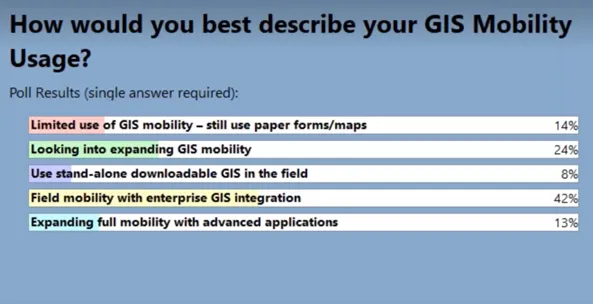
Over 50% of the respondents have embraced GIS mobility to a great extent. Still, nearly 40% have not fully leveraged mobility. Like its social media cousin, field mobility puts the power of GIS, mapping, spatial analysis, and rapid response in the hands of the people closest to work—those in the field and the trenches.
Fully deployed GIS mobility does a couple of things. First, it upgrades the quality of the data.
The long-standing issue with GIS is the data’s accuracy, timeliness, and completeness. Utilities have suffered from the problem of GIS backlog. Paper sheets, red-lined as-built sketches, and field notes piled on harried employees’ desks. Should this process continue with fewer employees, the data latency will increase. Rapid reporting of damage, data errors, and missing information supplied on map-based mobile devices that everyone uses today slash the time from the field to the office from days, months, and years to seconds.
Second, GIS mobility linked to dashboards enables immediate enterprise communication, coordination, and collaboration. Dashboards immediately show mobile worker input to every level of management. It helps answer the age-old utility operations question: what’s happening now? Dashboards foster rapid decision-making and assessment during construction and upgrade projects, routine inspection and maintenance, and when outages and emergencies occur.
Here are examples of how utilities migrated from their former paper processes to GIS mobile technology. The benefits are astounding – better data quality, faster response, efficiency, and lower costs. Unraveling old processes is how the industry can face the challenges squarely.
Innovation, like its first cousin, digital transformation, involves changing behavior and embracing digital technology. Here are some examples of how deploying GIS-based mobility applications has unraveled legacy processes, smoothed operations, and upgraded data quality. Here are some noteworthy examples:
Tohono O’odham Utility Authority (TOUA) is located in southern Arizona on the Tohono O’odham tribal land. Work processes had suffered due to the lack of authoritative utility records. Staff deployed mobile technology using ArcGIS Field Maps and other Esri mobile apps. TOUA deployed ArcGIS Dashboards to communicate with all stakeholders. The benefits were a dramatic reduction in complaints and labor for routine work. TOUA deployed Eos Arrow Gold Global Navigation Satellite System (GNSS) receivers fully integrated with ArcGIS for precision asset location.
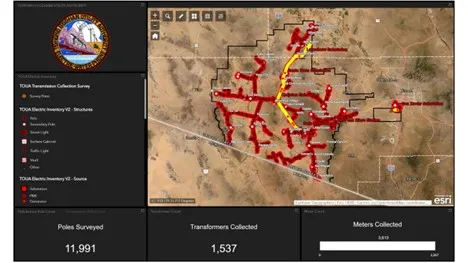
Situated on Florida’s Atlantic coast, the Utilities Commission of New Smyrna Beach (UCNSB) had an issue with the locational accuracy of its assets. So, like TOUA, it implemented the Esri solution coupled with the high-accuracy GSNN receivers from EOS to provide highly accurate locations of their assets. As a result, data quality was improved, resulting in lower operational costs and improved customer service.
The Muscat Electricity Distribution Company (MEDC) delivers power to the Governorate of Muscat, the capital of Oman. It serves over 450,000 customers. Despite leveraging its GIS to automate many processes, it still used paper forms for substation inspection. It migrated its inspection to GIS mobile devices and extensive use of dashboards. As a result, the company doubled the number of daily substations inspections it performed daily.
Central Electric Power Cooperative (CEPC) provides electric transmission services across 22,000 square miles of central Missouri. CEPC needed to improve field efficiencies for servicing, inspecting, and maintaining its 1,555-mile-long network. The issue was inaccurate maps resulting in wasted time. Thus, CEPC deployed GIS mobility apps. As a result, CEPC offers a common view to all staff from the office or the field. The utility has streamlined its operations and increased the efficiency of field activities.
ESO is one of the largest energy companies in the Baltics. It distributes gas and electricity to 1.8 million customers throughout Lithuania. The extensive use of paper maps and forms survived into the twenty-first century. The challenge for ESO was to create a digital transformation culture that would win the hearts and minds of employees steeped in the past. As a result of the strong paper process culture, the company lagged in making new customer connections. Data quality was lacking. Fixing and reporting defects in the field was overly burdensome and ineffective. ESO replaced all paper in the field with GIS-enabled tablets while eliminating all paper-based processes in the office. In addition, ESO created customized maps for network quality assessment.
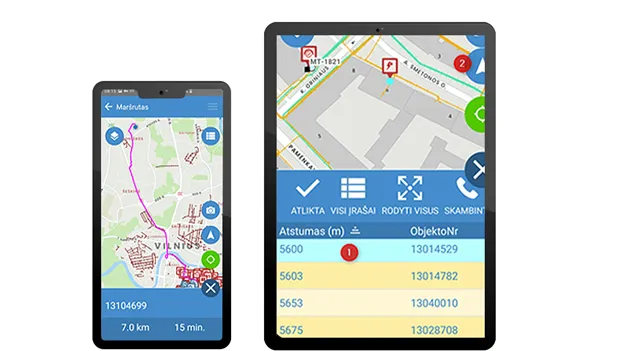
Just north of Milwaukee, Wisconsin, the City of Sheboygan Falls Utilities (SFU) provides electric service to approximately 4,100 residential, 52 large power, and 495 commercial customers. In 2021, facing the challenges posed by decades-old as-built data, the SFU field team decided to deploy GIS technology. Modernizing its entire process, the utility streamlined information sharing from the field to the office, improved customer care through faster and more accurate responses, and created more secure, real-time information sharing.
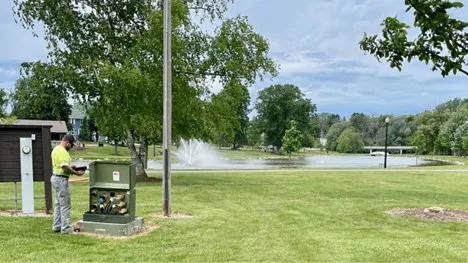
Putting the Pieces Together
Innovation is about thinking differently and changing behavior. GIS provides both the content and the context. The content includes detailed data about utility assets and customers. Content also includes real-time power, flooding, wind, and pollution measures. It also provides the context. Context includes location, clustering, customer demographics, land features, weather patterns, and various analytics. However, the data management processes over the decades have been spotty. Utilities must build better models of the existing systems, so they will need precise data as they move forward with significant expansion. That’s where the data collection process needs to be closer to the source of the data. Thus innovation starts with upping the quality of the data.
To learn more, click here to download our ebook on field mobility.

